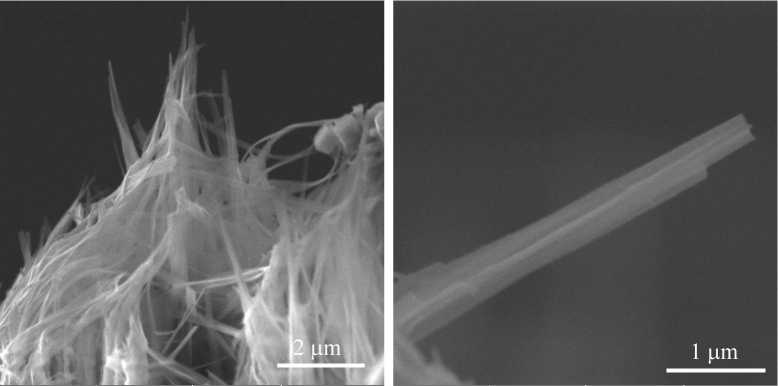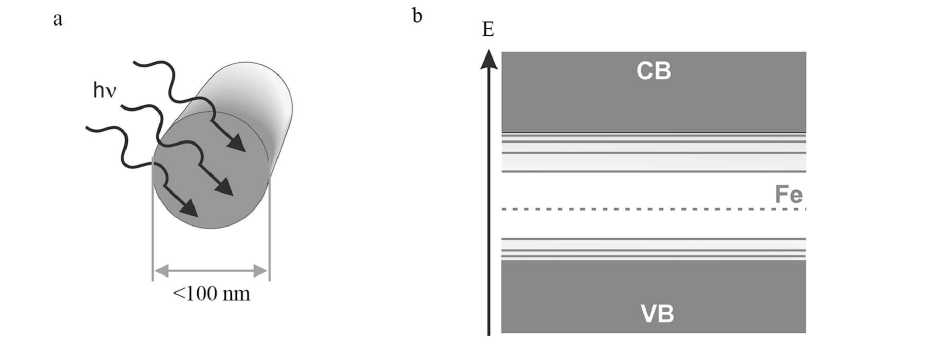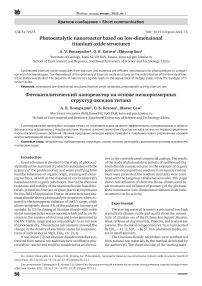Photocatalytic nanoreactor based on low-dimensional titanium oxide structures
Автор: Ponaryadov Aleksey, Kotova Olga, San Shieng
Журнал: Вестник геонаук @vestnik-geo
Рубрика: Научные статьи
Статья в выпуске: 1 (325), 2022 года.
Бесплатный доступ
Synthesized titanium oxide nanotubes from titanium raw materials are efficient nanoreactors for photocatalysis in comparison with macroanalogues. The dependence of the geometry of titanium oxide structures on the redistribution of the density of electronic states was studied. The presence of natural iron ligands leads to the appearance of midgap states inside the bandgap of titanium oxide.
Nanoreactor, low-dimensional structures, titanium oxide, nanotubes, photocatalytic activity, titanium raw
Короткий адрес: https://sciup.org/149139073
IDR: 149139073 | УДК: 547.992.3 | DOI: 10.19110/geov.2022.1.5
Текст научной статьи Photocatalytic nanoreactor based on low-dimensional titanium oxide structures
Great attention is devoted to the study of photocat-alytically active materials [1], which is associated with the urgency of the problem of air and water purifying from harmful substances of organic origin, creating self-cleaning surfaces, as well as the disposal of environmentally hazardous toxic organic substances. Due to the chemical resistance and stability of the titanium dioxide-based materials properties, they are of great practical importance for this field of application. Due to its zone structure titanium dioxide shows photocatalytic properties when exposed to electromagnetic radiation of the UV range, which allows using only about 4 % of the radiation intensity of sunlight. In [2] the doping of titanium dioxide with noble metal nanoparticles was proposed, which led to an increase in the number of electrons and holes generated in the UV/Visible range and correspondingly to an increase in photoactivity. Theoretical calculations showed the change in the density of electronic states for nanostructures of such oxides as MgO, TiO2, etc. [3, 4].
It was shown [5] that titanium dioxide nanotubes synthesized from natural raw materials were an effective pho-tocatalytic reactor and could be considered as an alterna- tive to the currently used commercial analogs. The results of the study of photocatalytic activity of synthesized titanium dioxide nanostructures on the example of organic pollutants decomposition reaction in an aquatic environment were presented, the reaction constants were calculated with the Langmuir-Hinshelwood model. This paper shows redistribution of electrons in low-dimensional oxide structures and influence of geometry of the photocat-alytic nanoreactor (one-dimensional titanium oxide nanostructures) on its activity.
Experimental
The starting material is mainly a mixture of two high crystallinity phases: rutile and quartz (from the concentrate of titanium ore of the Pizhemskoe deposit, Russia). Weak reflexes of clay minerals, ilmenite, and anatase are present. The chemical composition (wt. %) is represented by TiO2 — 42.12, SiO2 — 46.57. Iron, aluminum oxides, etc. are in small amounts.
The titanium dioxide nanotubes were synthesized from natural raw materials by the method developed by the authors [6]. The shape and size of the starting mate-

Fig. 1. Titanium dioxide nanotubes
Рис. 1. Нанотрубки диоксида титана
rial and synthesized samples were investigated by scanning electron microscopy (TESCAN Vega 3). The chemical composition was determined by the X-ray fluorescence method (Shimadzu XRF-1800).
Results and discussion
The phase composition of the synthesized sample is represented by quartz and a low-crystallinity phase corresponding to the formed one-dimensional titanium oxide nanostructures identified as sodium-containing hydrated titanate (H2-xTi3O7). SEM images (Fig. 1) allow estimating the geometric parameters of the obtained onedimensional nanostructures: outer diameter is about 50–115 nm, length is 5–6 µm. The chemical composition (wt. %): TiO2 — 74.68, SiO2 — 12.64, Fe2O3 — 5.44, Al2O3 — 4.71, Na2O — 0.14. Other elements are present in small amounts, which concentration and composition depend on the starting raw material and synthesis conditions.
Structural transformation at the nanoscale — the formation of titanium dioxide nanotubes from natural raw materials — leads to a decrease in the bandgap width: 2.4 eV for titanium dioxide nanotubes in contrast to anatase (3.2 eV). In [2] a similar effect was achieved by dop- ing with gold (or silver) nanoparticles, which formed additional states in the bandgap, and, as a consequence, there was a shift of the absorption towards the visible radiation and enhancement in the electron-hole pair generation processes.
In the case of structural transformation, the shift of the absorption towards visible radiation and the activation of electron-hole pair formation (i.e., reactivity) and catalytic activity are achieved due to a higher proportion of surface atoms as well. When considering the absorption of various types of radiation by titanium oxide nanostructures, we can assume that the proportion of surface atoms equals 100 %, i. e., assume that absorption occurs throughout the nanoparticle (Fig. 2a). In addition, the wave functions describing the electronic states in one-dimensional nanostructures are limited to one direction, which is dictated by their geometry (nanotubes can be considered onedimensional objects) [7]. Near the upper boundary of the valence band and the lower boundary of the conduction band, the distribution of density of electronic states takes on a discretization (Fig. 2b).
The isomorphic iron impurity is a natural ligand (doping atom), due to which an additional allowed state appears inside the bandgap [8].

Fig. 2. Absorption of electromagnetic radiation by one-dimensional nanoparticles (a); discretization of the electron state density distribution in nanoparticles and appearance of midgap state inside the bandgap due to isomorphic impurities (b)
Рис. 2. Поглощение электромагнитного излучения одномерными наночастицами (a); дискретизация распределения плотности электронных состояний в наночастицах и появление дополнительных разрешенных уровней внутри запрещенной зоны благодаря изоморфным примесям (b)

Conclusion
Structural transformation at the nanoscale — the formation of titanium dioxide nanotubes from natural raw material — leads to a decrease in the bandgap width to 2.4 eV. The isomorphic iron impurity results in the appearance of an additional state inside the bandgap, and, as a consequence, also shifts the absorption towards visible radiation. The obtained nanostructures of titanium oxide are more active photocatalytic nanoreactors in comparison with their macroanalogs due to the structural transformation at the nanolevel and the natural doping atom (iron).
Acknowledgment
The reported study was funded by RFBR and NSFC according to the research project RFBR № 20-55-53019 and NSFC № 42011530085.
Список литературы Photocatalytic nanoreactor based on low-dimensional titanium oxide structures
- Ni, Meng, Leung M. K. H., Leung D. Y. C., Sumathy K. A review and recent developments in photocatalytic water-splitting using TiO2 for hydrogen production // Renewable and Sustainable Energy Reviews. 2007. Vol. 11, no. 3. Pp. 401-425.
- Sano T., Negishi N., Uchino K., Tanaka J., Matsuzawa S., Takeuchi K. Photocatalytic degradation of gaseous acetaldehyde on TiO2 with photodeposited metals and metal oxides // Journal of Photochemistry and Photobiology A: Chemistry. 2003. Vol. 160. Pp. 93-98.
- Noguera C., Pojani A., Casek P., and Finocchi F. Electron redistribution in low-dimensional oxide structures // Surface Science. 2002. Vol. 507-510. Pp. 245-255.
- Loginova A. S., Ignatov S. K., Chukhmanov E. P., Salomatina E. V., Smirnova L. A. Structure, spectra, and photoinduced electron-redistribution properties of TiO2/organic copolymers with gold nanoparticles. A DFT study // Computational and Theoretical Chemistry, Volume 1118, 2017, Pages 1-15.
- Harja M., Kotova O., Sun S., Ponaryadov A., Shcheme-linina T. Efficiency evaluation for titanium dioxide-based advanced materials in water treatment. In: Glagolev S. (Ed.): ICAM 2019, SPEES, pp. 255-258.
- Котова О. Б., Понарядов А. В., Гёмзе Л. А. Гидротер-мический синтез нанотрубок диоксида титана из концентрата титановой руды Пижемского месторождения (Россия) // Вестник института геологии. 2016. 1 (253). pp. 34-36.
- Madden A. S., Hochella M. F. A test of geochemical reactivity as a function of mineral size: Manganese oxidation promoted by hematite nanoparticles // Geochimica et Cosmochimica Acta. 2005. Vol. 69, No. 2. Pp. 389-398.
- Chen, C.-H.; Peng, Y.-P.; Lin, M.-H.; Chang, K.-L.; Lin, Y.-C.; Sun, J. Iron Modified Titanate Nanotube Arrays for Photoelectrochemical Removal of E. coli. // Nanomaterials 2021, 11, 1944.


